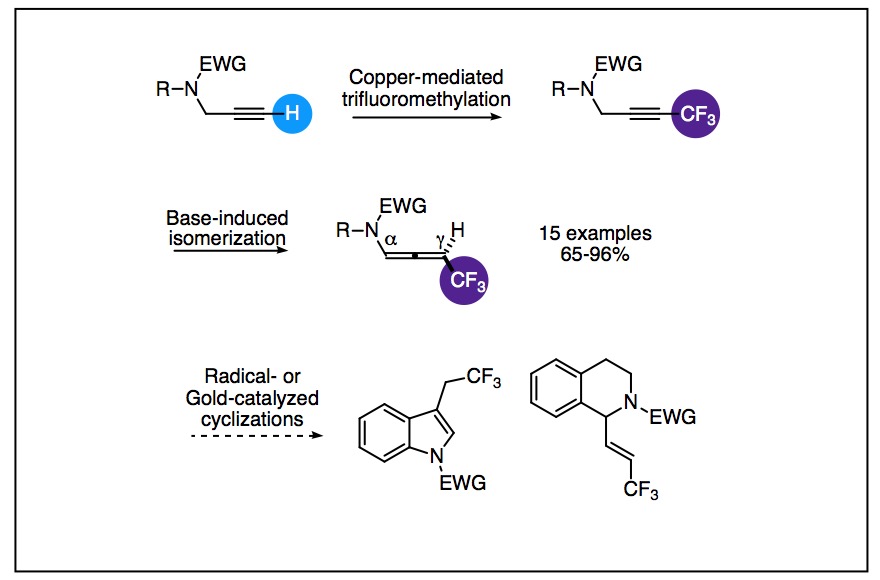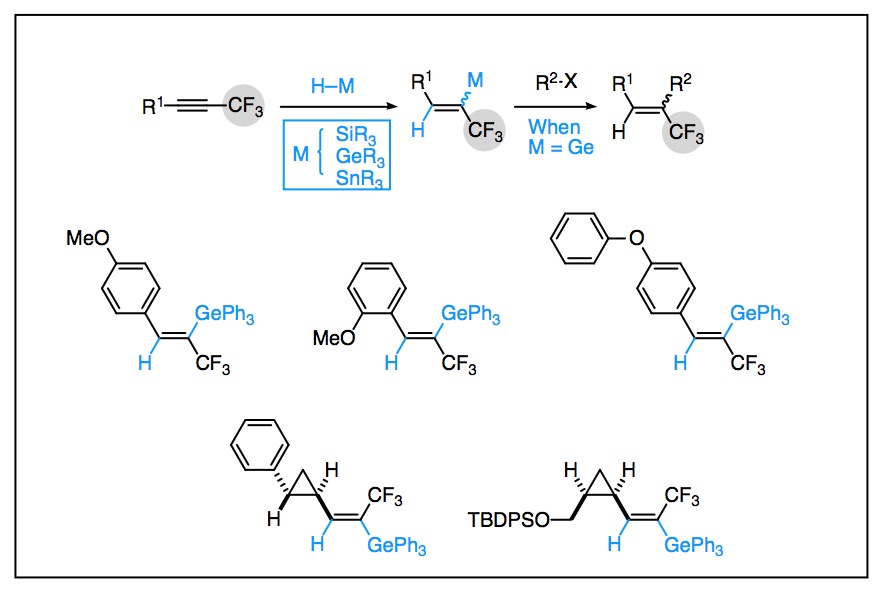1) Copper mediated reactions in organic synthesis
Copper is a fascinating metal that has a long history in organic chemistry. The recent and truly remarkable advances that have been reported in the past decade in copper mediated transformations have been a source of inspiration for our research, both for methods development (such as the direct trifluoromethylation of terminal alkynes, in collaboration with Professor G. Evano, University of Brussels, Belgium) and for their applications to the total synthesis of biologically relevant molecules (such as the Liebeskind-Stille cross-coupling for the synthesis of the southern fragment of mycolactone A/B).
For selected references, see:

2) Domino cycloaddition reactions
For the past years, we have been interested in the synthesis of original N-containing heterocycles for pharmaceutical and agrochemical industries. In this regard, domino Diels-Alder cycloaddition reactions are powerful tools that allow a rapid increase in product complexity for simple building blocks. Current efforts are dedicated to the synthesis of fused pyridines using intramolecular version of domino [4+2]/retro-[4+2].
For selected references, see:

3) Synthetic methods for material sciences
For the past few years, we have been involved in the synthesis of building blocks and catalysts (whether metallic or fully organic) for material sciences, with a special focus on photopolymerization reactions in collaboration with Professor J. Lalevée (IS2M, Université de Haute-Alsace, France) and Professor J.-P. Goddard (Université de Haute-Alsace, France).
For selected references, see:

4) Stereoselective hydrometallation of polarized C≡C bonds
Alkynes are fascinating building blocks whose reactivity is at the crossroad of numerous transformations. We have been studying hydrometalation reactions of polarized alkynes since 2014 to synthesize stereodefined vinylmetal and vinylmetalloids that can engage in further cross-couplings. The interplay of such alkynes with cycloaddition reactions is also under investigation.
For selected references, see:

5) Pentafluorosulfanyl (SF5) chemistry
Among the so-called “emerging” fluorinated groups, the pentafluorosulfanyl group (SF5) is of growing interest in heterocyclic synthesis, material science, and medicinal chemistry. However, synthetic routes to SF5-containing compounds and their structural diversity remain highly challenging. In 2020, our group started to explore the reactivity of pentafluorosulfanyl group and develop new synthetic methods.
For selected references, see:

1) Deciphering the biological mechanism of Buruli ulcer thanks to total synthesis
Buruli ulcer is a necrotizing skin disease present in more than thirty countries in the world, located mainly in West and Central Africa but also in Australia and now Japan. This infection is caused by Mycobacterium ulcerans that secretes a toxin called mycolactone. Since 2006, we have been involved in a research program at the frontier of total synthesis and immunology, aiming at better understanding the mode of action of these human toxins. We have devised a modular synthetic approach that allowed us to discover the first structure-activity relationship of these toxins. Based on this knowledge, structurally related fluorescent hybrids were prepared and used in confocal microscopy. In collaboration with the group of Dr. C. Demangel (Pasteur Institute of Paris), these informations were crucial in the discovery and confirmation of the first proteic target of mycolatones, a long-standing goal in this research area.
For selected references, see:
